
Teresa of Ávila, OCD, also called Saint Teresa of Jesus, was a Carmelite nun and prominent Spanish mystic and religious reformer.

Elizabeth Ann Bayley Seton was a Catholic religious sister in the United States and an educator, known as a founder of the country's parochial school system. Born in New York and reared as an Episcopalian, she married and had five children with her husband William Seton. Two years after his death, she converted to Catholicism in 1805.
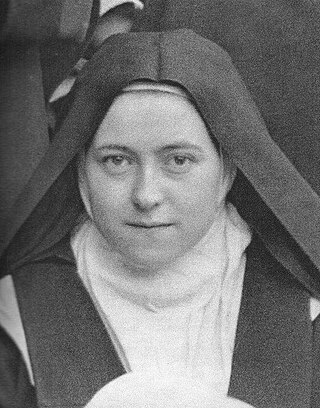
Therese of Lisieux, in religion Therese of the Child Jesus and the Holy Face, was a French Discalced Carmelite who is widely venerated in modern times. She is popularly known in English as the Little Flower of Jesus, or simply the Little Flower, and in French as la petite Thérèse.
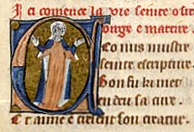
Osgyth was a Mercian noblewoman and prioress, venerated as an English saint since the 8th century, from soon after her death. She is primarily commemorated in the village of St Osyth, in Essex, near Colchester. Alternative spellings of her name include Sythe, Othith and Ositha. Born of a noble family, she became a nun and founded a priory near Chich which was later named after her.

Monica was an early North African Christian saint and the mother of Augustine of Hippo. She is remembered and honored in the Catholic and Orthodox Churches, albeit on different feast days, for her outstanding Christian virtues, particularly the suffering caused by her husband's adultery, and her prayerful life dedicated to the reformation of her son, who wrote extensively of her pious acts and life with her in his Confessions. Popular Christian legends recall Monica weeping every night for her son Augustine.
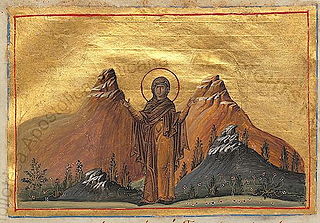
Thecla was a saint of the early Christian Church, and a reported follower of Paul the Apostle. The earliest record of her life comes from the ancient apocryphal Acts of Paul and Thecla.

The Acts of Paul and Thecla is an apocryphal text describing Paul the Apostle's influence on a young virgin named Thecla. It is one of the writings of the New Testament apocrypha. Edgar J. Goodspeed called it a "religious romance".
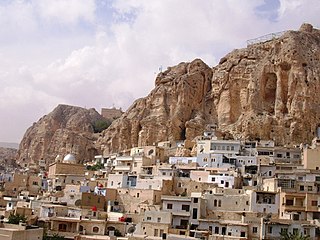
Maaloula is a town in the Rif Dimashq Governorate in Syria. The town is located 56 km to the northeast of Damascus and is built into the rugged mountainside at an altitude of more than 1,500m. It is known as one of two remaining villages where Western Neo-Aramaic is spoken, the other one being the nearby smaller village of Jubb'adin. Until the Syrian Civil War, Bakhʽa also had speakers of Western Neo-Aramaic. However, Bakhʽa was completely destroyed during the war, and all the survivors fled to other parts of Syria or to Lebanon.

Marianne Cope, OSF, was a German-born American religious sister who was a member of the Sisters of St. Francis of Syracuse, New York, and founding leader of its St. Joseph's Hospital in the city, among the first of 50 general hospitals in the country. Known also for her charitable works, in 1883 she relocated with six other sisters to Hawaiʻi to care for persons suffering leprosy on the island of Molokaʻi and aid in developing the medical infrastructure in Hawaiʻi. Despite direct contact with the patients over many years, Cope did not contract the disease.
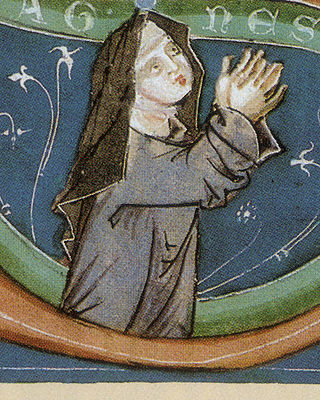
Agnes of Bohemia, O.S.C., also known as Agnes of Prague, was a medieval Bohemian princess who opted for a life of charity, mortification of the flesh and piety over a life of luxury and comfort. Although she was venerated soon after her death, Agnes was not beatified or canonized for over 700 years.

Leoba, was an Anglo-Saxon Benedictine nun and is recognized as a saint. In 746 she and others left Wimborne Minster in Dorset to join her kinsman Boniface in his mission to the German people. She was a learned woman and was involved in the foundation of nunneries in Kitzingen and Ochsenfurt. She had a leading role in evangelizing the area. Leoba was acclaimed for many miracles: saving a village from fire; saving a town from a terrible storm; protecting the reputation of the nuns in her convent; and saving the life of a fellow nun who was gravely ill – all accomplished through prayer. Her first letter to Boniface contains the first poetry known to have been written by an English woman. |

Athracht is the patron saint of the parish of Locha Techet and Tourlestrane, County Sligo, Ireland. She was a sister of Bishop Conal of Drumconnell. Her feast day is 11 August.

February 1 - Eastern Orthodox liturgical calendar - February 3
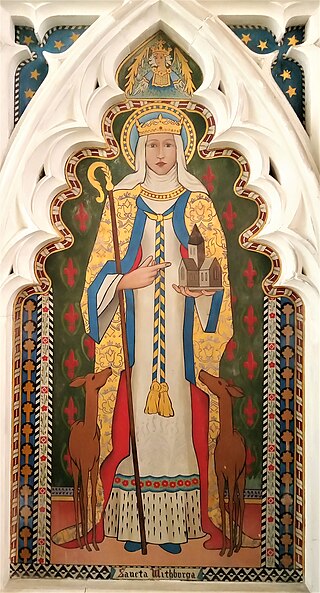
Wihtburh was an East Anglian saint, princess and abbess. According to tradition, she was the youngest daughter of Anna, king of the East Angles, but Virginia Blanton has suggested that the royal connection was probably a fabrication. One story says that the Virgin Mary sent a pair of female deer to provide milk for Wihtburh's workers during the construction of her convent at Dereham, in Norfolk. When a local official attempted to hunt down the does, he was thrown from his horse and killed.

October 14 - Eastern Orthodox liturgical calendar - October 16

Chiara Offreduccio, known as Clare of Assisi, is an Italian saint who was one of the first followers of Francis of Assisi.

Maria Faustyna Kowalska of the Blessed Sacrament, OLM was a Polish Catholic religious sister and mystic. Faustyna, popularly spelled "Faustina", had apparitions of Jesus Christ which inspired the Catholic devotion to the Divine Mercy, therefore she is sometimes called the "secretary" of Divine Mercy.
Saint Thecla of Kitzingen was an Anglo-Saxon Benedictine, nun, abbess, and missionary. She was one of a number of figures associated with Saint Boniface and the Anglo-Saxon mission.

Margaret Clitherow was an English recusant, and a saint and martyr of the Roman Catholic Church, known as The Pearl of York. She was pressed to death for refusing to enter a plea to the charge of harbouring Catholic priests. She was canonised in 1970 by Pope Paul VI.

The Convent of Saint Thecla is a Greek Orthodox convent in Maaloula, Syria. It is administered by the Greek Orthodox Patriarchate of Antioch. The convent was built in 1935 around the grotto of St. Thecla.


















